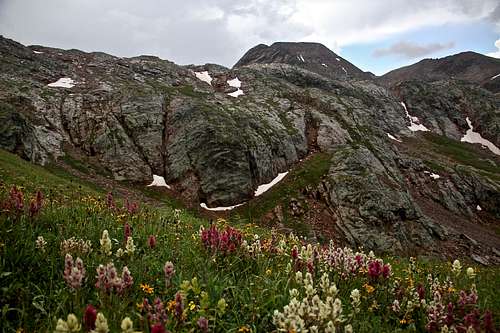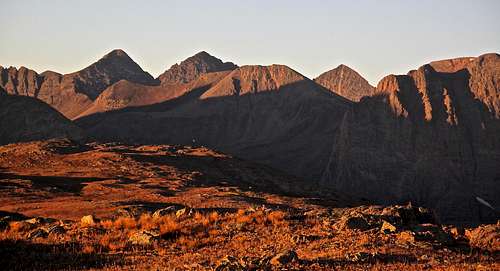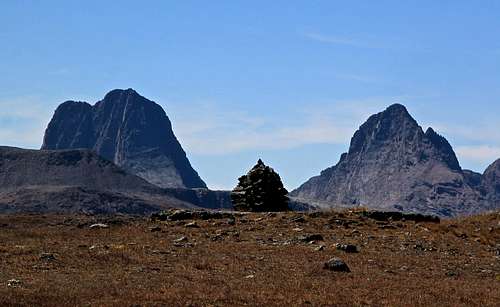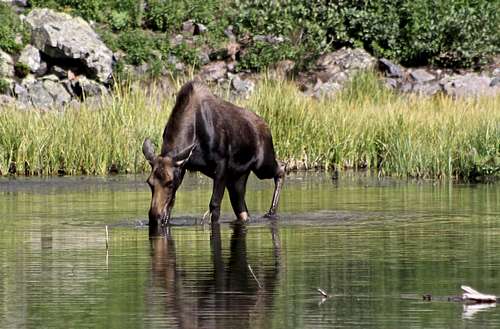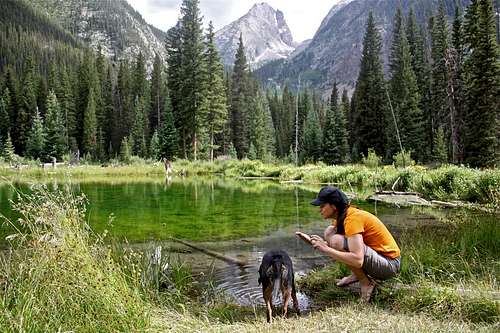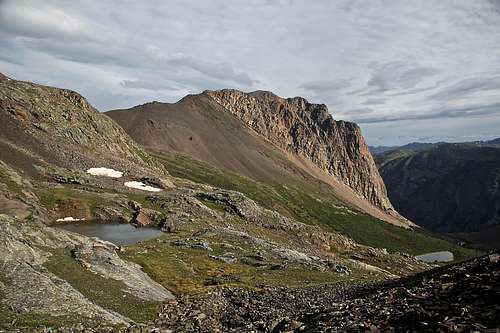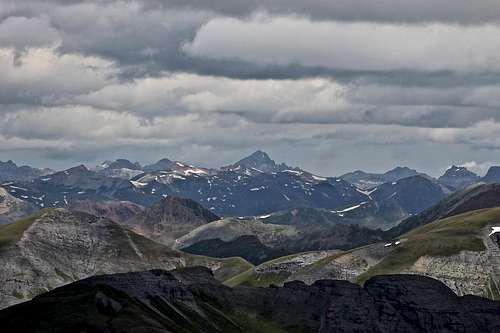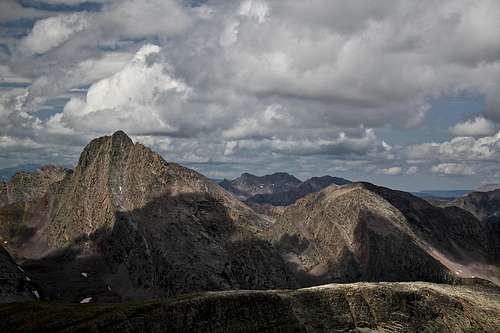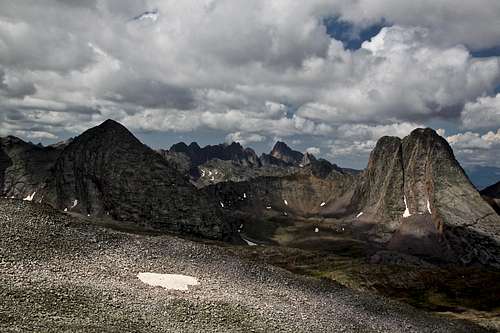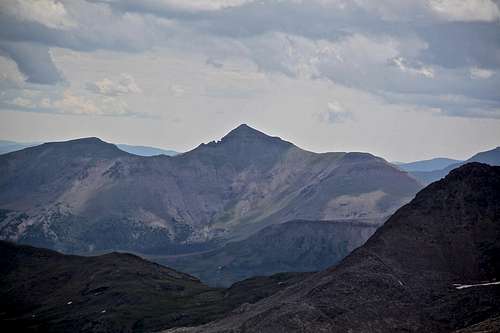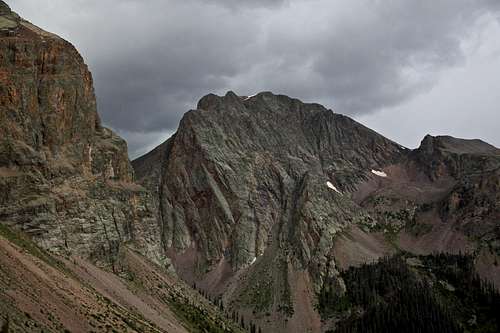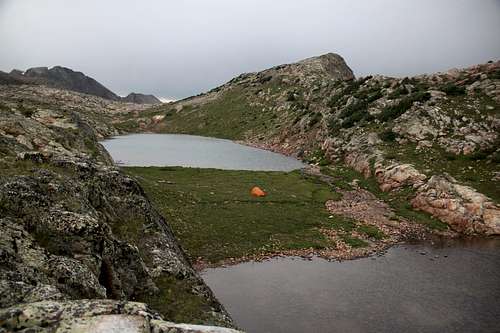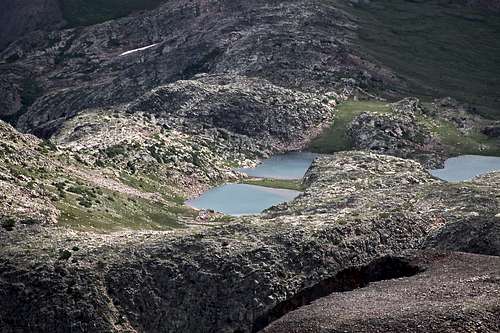-
 7388 Hits
7388 Hits
-
 82.48% Score
82.48% Score
-
 15 Votes
15 Votes
|
|
Mountain/Rock |
|---|---|
|
|
37.70837°N / 107.57599°W |
|
|
San Juan |
|
|
Hiking, Mountaineering, Scrambling |
|
|
Spring, Summer, Fall, Winter |
|
|
13475 ft / 4107 m |
|
|
Overview
Peak Two is located in the Weminuche Wilderness (the largest wilderness in Colorado) of San Juan Mountains. Technically, the peak is still located within Grenadier range although it is north of the main Grenadiers east to west running spine of peaks. The views from its summit are amazing, especially over Vestal and Arrow Peaks. Peak Two combines really nicely with Peak Three. A longer and more difficult combination would be White Dome, Peak One, Peak Three and Peak Two. And the most difficult combination would be Trinity Traverse and then walking over Peak Three to Peak Two.Peak Two is not very high per Colorado Standards. It does not make the bicentennial list (= not among the highest 200), and since it is hard to approach, expect solitude.
Guide to the Colorado Mountains with Robert Ormes (sort of a bible of Colorado mountains) again is very brief: "To gain Peak Three (13,478') from a camp in the Vestal Creek drainage, climb steeply out of the drainage to the flats above 12,800'. Walk up the west ridge. A moderate climbing route is also is possible by way of Vestal Creek - Trinity Creek saddle and the south ridge. Walk up Peak Two (13,475') from the flats by ascending its south ridge."
The San Juan Mountains: A Climbing and Hiking Guide by Robert Rosebrough offers very little as well: "To the north, Peaks One, Two and Three, and White Dome separate the Grenadiers from Continental Divide". The routes Rosebrough mentioned are different that the route I took. See route section below.
Camping in upper Vestal Basin is excellent and gorgeous - you can set up your tent just below Trinity Peaks. Hike up to Trinity Pass and take the south ridge to the summit of Peak Three and continue over to Peak Two. This is a great option if you plan only for Peaks Three and Two.
Colorado Rank: 270
Line Parent: Peak Three
Class: 2
Nearby Peaks:
- Peak Three (13,478 feet = 4108 m) 0.84 miles
- Peak One (13,589 feet = 4142 m) 1.27 miles
- White Dome (13,627 feet = 4154 m) 1.64 miles
- Trinity Peak (13,805 feet = 4207 m) 1.66 miles
- West Trinity (13,765 feet = 4195 m) 1.67 miles
- East Trinity (13,745 feet = 4189 m) 1.68 miles
- Vestal Peak (13,864 feet = 4226 m) 1.97 miles
- Arrow Peak (13,803 feet = 4207 m) 2.6 miles
- Electric Peak 2.35 miles
- Storm King Peak (13,752 feet = 4192 m) 2.38 miles
- Hunchback Mountain (13,136 feet = 4004 m) 2.45 miles
- Peak Eight 2.62 miles
- Peak Nine (13,402 feet = 4085 m) 2.81 miles
Getting There
What is your priority? If you wish to climb only Peak Two (or Peak Two and Three) and avoid long rough 4WD road, access from the upper Vestal Basin is your best option. You can take either a train (scenic Durango-Silverton rail) to Elk stop and hike from here into Vestal Basin. Most people wish to combine this peak with others since it is hard to approach. If combining with other numbered peaks (One, Three and White Dome) then access from Beartown/Kite Lake is better.
4WD Road to Beartown/Kite Lake:As mentioned above Peak Three is located deep within the Weminuche Wilderness of the San Juan Mountain Range. The shortest way to reach it is via 4WD road to Beartown (there is nothing left of Beartown, do not expect even a ghost town). You need a high clearance vehicle since you will need to cross several streams, including Rio Grande. Water levels vary based on conditions, e.g. recent rain or spring time run off from melting snow. (We found it pretty deep even in early September in 2015, July 2016 was less deep).
The road to Beartown is accessible either from Silverton or from Lake City/Creede/Rio Grande Reservoir. I would recommend driving in from Silverton - shorter, and easier. I drove it both ways and found the road towards Rio Grande Reservoir in a bad shape - mostly water damage, would not want to take my car on it again (September 2015). The road from Silverton is in much better shape and faster.
From Silverton drive northeast on the main street through town past the courthouse and take a right on Colorado Highway 110, County Road 2 toward Howardville. Pavement ends after a couple of miles. Around 4.2 miles you reach Howardsville (mostly mining buildings). Take a right turn here on a well signed road Stony Pass/Cunningham Gulch, FS 589. Shortly you come to an intersection - one to the left is signed for Old Mine Tour, the other one close to the creek continues straight. It does not matter which one you choose, both reconnect after a couple of miles, and neither is technically challenging. You have to leave Cunningham Gulch and start climbing on a narrow 4WD road towards Stony Pass - FS 737. It is again marked and hard to miss. Mid July to August there are amazing wildflowers along the road. Stony Pass elevation is 12,590 feet. The road from the summit has relatively gentle grade, steep, but well kept. The road down from the pass all the way to Rio Grande Reservoir is numbered as FS 520. At 11.6 miles you reach an important intersection - well signed for Beartown/Kite Lake to the right, or straight (left) to Creede. The signs says Beartown only 4 miles, Kite Lake 6 miles - be aware that this section is rougher and takes me as long as the whole drive from Silverton.
From Lake City/Creede: again, I am not recommending taking this route, longer and in a worse condition, especially after a rain. Take Colorado Highway 149 to FS 520 and turn west toward Rio Grande Reservoir. There are several river crossings, deeply rutted sections, lots of deep puddles after a rain, narrow rocky steep sections making passing vehicles in an opposite direction impossible. It is about 25 miles long to get to the turn off for Beartown.
Once you have reached FS 506, the road to Beartown is another 4 miles (6.5 miles to Kite Lake). You have to cross Rio Grande right at the start of this road, the water can be pretty deep. The rest of the road is not bad, can get muddy after a rain and towards the end there are some rocky sections. I usually stop somewhere around mile 5 at the Continental Divide Trailhead/Hunchback Pass trailhead. There is a sign/kiosk at the start of the trail and enough place to park 2-3 cars, there are a few more car parks nearby (above the kiosk). The last mile of the road towards Kite Lake gets progressively worse.
On foot approaches:
1. Approach from the Highland Mary Lakes/ end of Cunningham Gulch out of Silverton. Passenger cars can make it close to a trailhead (to reach the actual TH it is better to have a 4WD - stream crossing required). You could either start your hike towards Highland Mary Lakes and turn off towards Continental Divide Trail less than 1 mile in skipping the lakes, or you can hike all the way through Highland Mary Lakes and connect with Continental Divide/Colorado Trail later on. The second options is slightly longer, but very scenic.
Expect hiking on a well established trail, well marked, well engineered cairns along the trail, incredibly beautiful scenery, and one of the best views into the Grenadier Range. The hike quickly ascends to above 12,000 feet and you continue your approach above the tree line and in a high elevation (keep this in mind during summer monsoon season). It is roughly 6-7 miles in (I did not measure the distance) to reach the Eldorado Lake below White Dome. Eldorado Lake is a great place to set up your campsite. This is the easiest and quickest backpack option for reaching White Dome and Peak One, and Peaks Three and Two.
There could be a slight variation to this backpacking option: drive to the east side of Stony Pass and hike Continental Divide/Colorado Trail from there. It would shortly connect with above mentioned Highland Mary Lakes trail and you would not have climb as much on your foot since your start would be already above 12,000.
2. Backpack from Molas Lake - Take Colorado Trail down Elk Park, cross the Animas River (nice footbridge), hike along the Durango Silverton Railroad for a short distance and continue on Elk Creek/Colorado Trail past beaver ponds towards the point where Colorado Trail connects with Continental Divide Trail. This approach is very long, requires a lot of ups and downs. The trail along Elk Creek is incredibly scenic and offers nice views into Grenadiers. The final ascent to reach the intersection of Colorado and Continental Divide trails goes through many switchbacks on grassy slopes, which are covered with wildflowers in the summer. It is less than 1/2 mile from here to reach Eldorado Lake. You don't need a 4WD car at all - you park along the main road 550, just below Molas Pass. Most people take two days for this approach. Camping along the Colorado trail is amazing - great primitive campsites.
3. Another variation of backpack from Molas Lake - you start as above, but at beaver ponds you turn off south towards Vestal Basin - this gives you an opportunity to explore Arrow Peak, Vestal Peak and Trinity Peaks. You can cross via Trinity Pass (expect a lot of scree over this steep pass) and drop into upper Stormy Gulch, or from the pass ascent Peak Three and then Peak Two. You can access Peak One and Three from upper Stormy Gulch by gaining its west ridge. (If you drop down from Trinity Pass towards Trinity Lake, you are in a great position to climb Storm King Peak, Silex and Guardian).
4. Another variation is to choose approach via Upper Elk Creek drainage into the basin between Peaks One, Three and Two. I have descended this way and would not recommend it for the way up. There is no established trail, expect lots of talus, scree, and boulder hopping + bushwhacking. However, for the descent the scree from the saddle between Peaks Two and Three was not bad and the basin is nice with an unnamed lake and lower there are several waterfalls on Elk Creek.
5. Stormy Gulch Approach - if planning a little backcountry experience - start at rough 4WD trailhead at Beartown, hike over Hunchback Pass - consider a quick stroll up Hunchback Mountain, descend down to Vallecito Creek, cross it and ascend up Stormy Gulch. Again, this approach is great if you want to climb Storm King Peak. The trail up Stormy Gulch is pretty non-existent now - too many fallen trees covered up the trail. The trail does re-appear higher up. Past Trinity Lake you ascend Trinity Pass and can go over Peak Three towards other numbered peaks and White Dome.
Route
The easiest approach for Peak Two is to reach the saddle between Peaks Three and Two. This saddle can be reached either by coming from Peak Three, or by scrambling directly to it from the west side = Vestal drainage, or from the east side = upper Elk Creek drainage. I route was over Peak Three and then descended into the upper Elk Creek basin (this descent was not bad, small scree was easy to ski down on, BUT I would not enjoy going up this way).
Rosebrough in his Climbing and Hiking Guide to San Juan Mountains is describing Southwest Ridge: From 11,400 feet in the Vestal Creek drainage across from Vestal Peak, climb up the steep north side of the drainage which flattens out at 12,800'. Once on top, walk over to the 12,940 saddle between Peaks Three and Two. The saddle also can be reached by climbing up the scree from the Elk Creek drainage. From the saddle, the southwest ridge is a rarity in Grenadiers - a walk up. Be prepared not to be disappointed by the false summit at 13,392 feet. The true summit is a rounded heap covered by boulders another quarter mile north.
Return the same way since to the north, west and east the Peak Two is very steep.
Return to your camp - either Vestal Creek, upper Storm Gulch or towards Colorado Trail - follow Elk Creek drainage. There is no established trail in the Elk Creek drainage - expect loose scree, then bush whacking, scrambling down rocks and boulders. The area is very scenic with many waterfalls. Peak Two from below looks very impressive!
If you are returning to Eldorado Lake, the shortest, but difficult return would be to scramble up to the saddle between Peak One and Point 13,453 - this is loose and steep, but it is the shortest way to Eldorado Lake and Kite Lake/Beartown area.
Red Tape
National Forest Service does not require purchasing permits when visiting wilderness. Hiking, camping and driving 4WD roads is all free.When to Climb
Summer is the easiest since the mountain is so for away from civilization. A winter trip would mean a travel for several days through avalanche prone country. The 4WD road to Beartown does not usually open till June and closes late in September (when the first snowstorm hits)Camping
Camping at Eldorado or Vallecito lakes if considering also White Dome and Peak One. Great camping is available at Eldorado Lake. Eldorado Lake is big and offers multiple private spots for camping, just keep in mind you are in a high country > 12,500 feet. There are no trees around to make a fire. The temperature changes quickly and it does get cold at night (I camped there once on October and the lake froze by am).
Vallecito Lake would be another good place for camping.
It is easy to access the saddle between White Dome and Peak One from both lakes. I think the access to the saddle appears easier from Vallecito Lake.
Another option for great and scenic camping and would be upper Storm Gulch. The views of Storm King Peak and several small lakes offer truly a spectacular place to spend a night.
Upper Elk Creek drainage (drainage between Peaks One, Three and Two) has a nice lake and offers nice camping. It is just hard to get there. There is no established trail leading up there. Dropping from here down to Colorado Trail meant a lot of boulder/talus hopping and bushwhacking.
Basically, you are in a wilderness area and basically you can camp anywhere.




